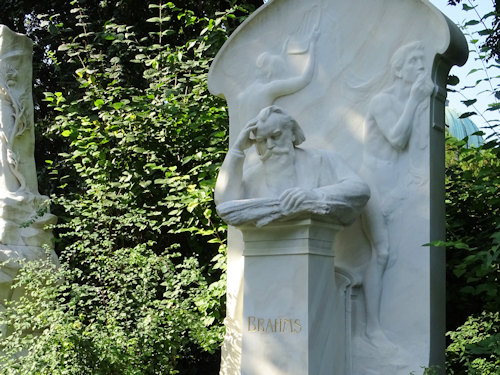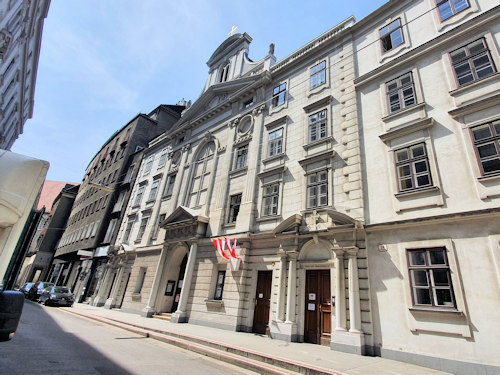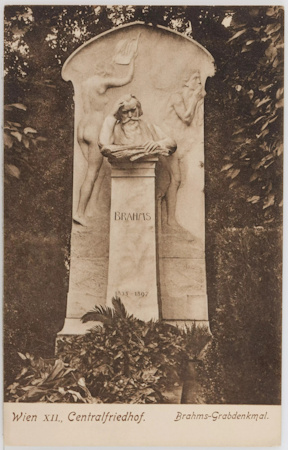Vienna echoes to the music of numerous legendary composers, including the great Johannes Brahms. Born in Hamburg, he lived permanently in Vienna from 1872 until his death in 1897 and occupies an honorary grave at the main cemetery.
- Funeral at the Stadtkirche, burial in the Zentralfriedhof
- Grave located next to Johann Strauss II
- …and near Schubert and Beethoven
- Easily reached by public transport
- Book a concert experience* in Vienna
- See also:
Brahms’ funeral and burial

(The headstone has a very simple inscription)
Johannes Brahms passed away on April 3rd, 1897 in his long-term residence on Vienna’s Karlsgasse. His rooms lay practically in the shadow of the great Baroque Karlskirche church and just a short walk from the Musikverein building (where two of his symphonies made their first public appearance).
The papers greeted Brahms’ death with appropriate sadness and sombre tones. The Neues Wiener Journal began their report thus (my rough translation):
Music has suffered an irreplaceable loss. One of its giants – Johannes Brahms – is no more.
The Neues Wiener Tagblatt struck a similar tone (also my rough translation):
The entire musical world is in deep mourning: Johannes Brahms is no longer alive. This most important of musicians, the greatest of today’s composer of symphonies has been taken from them

(The Stadtkirche where the funeral service was held)
At 2.30pm on April 6th, Brahms’ coffin and funeral procession left the collecting point in front of the Karlskirche and headed off toward the Lutheran Stadtkirche church on Dorotheergasse in the centre of Vienna’s old town.
Condolences and flowers had arrived from friends and admirers across Europe in such number that six vehicles were needed to carry them. Anton Dvorak and many other distinguished mourners from the arts, music, and politics followed the coffin.
The procession made a brief stop at the Musikverein for that institution to pay its last respects. The previous evening’s concert had begun with musical tributes to Brahms, their former artistic director and honorary member.
(Even today, one of the Musikverein’s two main concert halls is named the Brahms-Saal.)
The coffin then continued on to the Ring, turning to pass down the side of the State Opera House before eventually reaching the church.
Where is Brahms’ grave?

(The grave soon appeared on postcards, like this one produced by Wolf, Vereinigte Kunstanstalten, Wien around 1906–1907; Wien Museum Inv.-Nr. 235423; excerpt reproduced with permission under the terms of the CC0 licence)
After the service, they buried Brahms in an honorary grave at the city’s main cemetery, where a last speech included the promise to preserve his musical legacy for the future (a promise which certainly seems to have been kept).
You’ll find Brahms in Grave 26 of Group 32A in the Zentralfriedhof cemetery.
The permanent gravestone, sculpted by Ilsa Conrat, was added in 1903. The Brahms Museum in Hamburg also has a marble bust of Brahms by Conrat. And another Brahms bust by the same artist sits in the collection of historical instruments in Vienna’s Neue Burg.
Group 32A includes the last resting place of various artistic and musical personalities, most notably Beethoven and Schubert. And a memorial to Mozart, though his actual grave lies elsewhere.
Just over two years after Brahms, Johann Strauss II was buried here in the spot next to his friend. Other neighbours include further members of the Strauss family and Joseph Lanner.
As you face Mozart’s memorial with Beethoven’s grave behind, simply let your eye drift a few yards to the right to see three graves. Brahms is in the middle with Strauss on the left and Nikolaus Dumba (a major sponsor of the arts) to the right.

(The Brahms grave on the right with the grave of Johann Strauss II and his wife, Adele, on the left)
The cemetery is huge, but the musician graves lie close to the main entrance at Tor 2 (reached on trams 11 and 71; the latter leaves from central tram stops like Schottentor, Rathausplatz, Parlament, Ring/Volkstheater, Burgring, Oper/Karlsplatz, or Schwarzenbergplatz).
Once at Tor 2, just go through the gates and keep going in a straight line. The composer graves soon appear alongside the road on the left.
Address: Zentralfriedhof, Simmeringer Hauptstraße 234, 1110 Vienna
